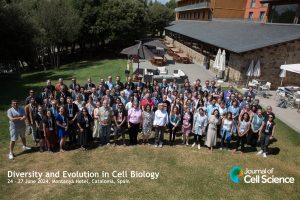16 September 2024

The Journal Meeting, Diversity and Evolution in Cell Biology, organised by Journal of Cell Science (JCS) took place from 24 June to 27 June 2024 in Catalonia, Spain. The aim of this meeting was to bring together evolutionary biologists and cell biologists investigating diverse aspects of cellular physiology, traversing both spatial scales – from subcellular cytoskeletal dynamics to symbiotic interactions – and evolutionary time.
Girish Kale is a preLights Ambassador and was recently interviewed as one of Development’s Pathway to Independence Programme Fellows. He recently attended the Diversity and Evolution in Cell Biology Journal Meeting, where he presented newly developed research in poster format that was at the interface of cell biology, developmental biology, tissue mechanics, and evolution. Here, he reports what it was like to attend.
I attended the JCS 2024 Diversity and Evolution in Cell Biology: a meeting that truly lived up to its name. Expectations were high; the meeting was a bit on the expensive side, especially for someone like me coming from a small lab. However, unlike other similarly expensive meetings, this was absolutely worth every penny. Plus, the organisers arranged everything: all the way from leaving Barcelona to attend the conference to the shuttle buses taking us back to airport/train-station. The meeting was in a rather scenic location, all in all promising to be exciting and setting itself for success. The meeting being organised by Journal of Cell Science was a plus: personally, this was an apt demonstration of the culture in such community journals and highlighted the need for not-for-profit organizations such as The Company of Biologists, which is the journal’s parent organisation.
The core of every meeting is the people and their science: this meeting had shortage of neither. From a certain point of view, this was a small meeting of about 100 participants. Though, with over 50 posters, the science was plenty. There were people coming from all over the world, showing their latest and greatest results: from tardigrades to vertebrates, from microscopic multicellular organisms to gigantic unicellular ones. The meeting was a melting pot of techniques too: from classical techniques like chopping the organism to study its regeneration, all the way to single cell RNAseq, and advanced microscopy techniques.
The scope of the meeting also made one reflect on the past and the future of cell biology. For long, cell biology was limited to culturable unicellular organisms, or larger models such as chicken embryos, where a lot of cells were rather easily available for all sorts of experiments. Naturally, there was a gap: smaller organisms that are harder to culture, or smaller multicellular organisms were out-of-scope for cell biological interrogations with classical approaches. Not anymore! The meeting was full of talks from scientists who are pushing the boundaries of what is possible. A clear highlight of the conference was the European Molecular Biology Organization (EMBO) Young Investigator Lecture by Dr Omaya Dudin from EPFL, Switzerland. His use of expansion microscopy to explore multicellular developmental diversity, in over 200 species, was an excellent showcase of what the modern cell biologists are daring to achieve.
Being a developmental biologist by training, at times I felt a bit lost at this meeting, making me awkward asking the most basic questions: I had to look up what Opisthokont and excavates were. But the poster sessions were great in this aspect, as I could take my time to discuss and understand the intricate details of the science. This was also the first time I was presenting our work, so it was quite exciting to see how that was perceived. I got to try out various narratives while explaining the work in poster sessions. Then, I got to also discuss my main research interest, where I am focusing on the effect of elevated temperature at cell biological level, during early embryonic development in flies.
Another novelty of the conference was well executed social mixing. Given the diversity of the topics, there was a great chance of social fragmentation, with participants retreating into silos of their favorite experimental systems or organisms. The organisers paid special attention to making sure that this didn’t happen: scientific speed networking “encouraged” the participants to talk to people working on unrelated topics, where we shared our excitement with a new group of people after every 10-15 minutes. Something similar happened over meals as well, as occasionally there was a randomised sitting arrangement, giving the opportunity for serendipity to work its magic. This was especially true for the conference dinner, where we were sitting at round tables, feeling like we were at someone’s wedding. And, indeed, we were: this was a destination wedding of Diversity and Evolution, where cell biologists celebrated exciting science and happily returned with new enthusiasm for their future experiments.
We thank Girish for his report on this Journal Meeting as he shows a great example of stepping out of your scientific comfort zone and to try out new experiences and connections with this meeting.








You must be logged in to post a comment.